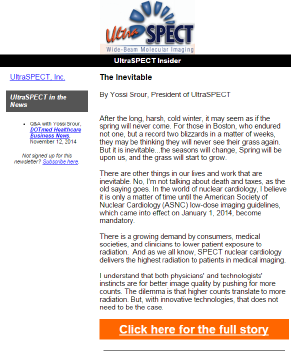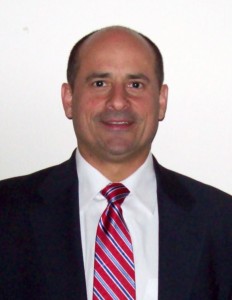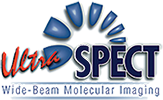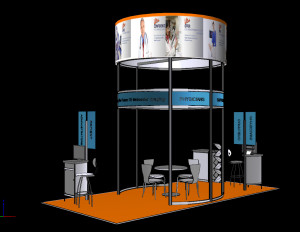 The Inevitable
The Inevitable
By Yossi Srour, President of UltraSPECT
After the long, harsh, cold winter, it may seem as if the spring will never come. For those in Boston, who endured not one, but a record two blizzards in a matter of weeks, they may be thinking they will never see their grass again. But it is inevitable…the seasons will change, Spring will be upon us, and the grass will start to grow.
There are other things in our lives and work that are inevitable. No, I’m not talking about death and taxes, as the old saying goes. In the world of nuclear cardiology, I believe it is only a matter of time until the American Society of Nuclear Cardiology (ASNC) low-dose imaging guidelines, which came into effect on January 1, 2014, become mandatory.
There is a growing demand by consumers, medical societies, and clinicians to lower patient exposure to radiation. And as we all know, SPECT nuclear cardiology delivers the highest radiation to patients in medical imaging.
I understand that both physicians' and technologists' instincts are for better image quality by pushing for more counts. The dilemma is that higher counts translate to more radiation. But, with innovative technologies, that does not need to be the case. In fact, there are a few available technologies that enable the use of fewer counts to generate improved image quality. UltraSPECT is one of the solutions, and our products were designed to positively offset reduced-count density data. Each of the algorithms has been optimized to different count densities while enabling the best image quality to be achieved with reduced-count-density data. Thus, to comply with the market demand for low radiation, we recommend that nuclear medicine imaging facilities follow the ALARA principle for injected dose to be "as low as is reasonably achievable" by using low-count density technology (reconstruction software or a solid-state camera).
We all understand that it is not a question of IF the ASNC low-dose guidelines will become mandatory, but WHEN. As a medical community, we need to be prepared, and it will take time to change the general practice of nuclear cardiology. So, the sooner the better, because the change is inevitable.
UltraSPECT is one of several low-dose solution providers in the market. However, UltraSPECT is the ONLY vendor-neutral, low-dose imaging solution for ALL cameras, regardless of age or manufacturer, which enables low-dose exams to be offered to every patient and every exam.
In this issue of our newsletter we feature a long-time UltraSPECT customer, Duke University Medical Center. As with any technology there are the early adopters, and Duke has the distinction of being one of UltraSPECT’s early adopters and has provided its patients with the lowest possible dose for nearly a decade. When the ASNC guidelines become mandatory, we look forward to working with many more of you.
Regards,
Yossi
 Q&A with Robert Pagnanelli, Chief Technologist, Nuclear Medicine, Nuclear Cardiology, PET at Duke University Medical Center
Q&A with Robert Pagnanelli, Chief Technologist, Nuclear Medicine, Nuclear Cardiology, PET at Duke University Medical Center
Q: So tell us, what is the mood at Duke University now that the Blue Devils have won a fifth NCAA men’s basketball crown?
RP: It has been fantastic. There’s a lot of excitement all over campus. In this area of the country, basketball is the most popular sport. The medical center is right next to the campus. The day after, as I arrived to work early, the celebration hadn’t yet stopped.
This has been an exciting year in college sports for me. I did my training at The Ohio State University and they won the football national championship this year.
Q: Is that where you found an interest in nuclear medicine, at Ohio State?
RP: It is. Ohio State is a large university which presented many options. I knew I was interested in healthcare. I had the opportunity to observe multiple specialties and became intrigued by medical imaging. I was accepted into the baccalaureate radiologic technology program. Nuclear medicine was definitely my favorite rotation. I stayed for an additional year of training in nuclear medicine.
Q: How did Duke come to use UltraSPECT?
RP: UltraSPECT asked us to partner with them. Initially, I was skeptical, as were most. It’s embedded in people who work in nuclear medicine that more counts are better. It was a change in our thought process. As we worked on validating the new approach and comparing half-count studies processed with UltraSPECT to the traditional full-time acquisitions processed with filtered back projection, we could see that while being efficient we were at least maintaining quality. Seeing is believing—we can achieve comparable diagnostic results with reduced exam times and/or reduced dose. The publication by Borges-Neto, et al, Clinical Results of a Novel Wide Beam Reconstruction Method for Shortening Scan Time of Tc-99m Cardiac SPECT Perfusion Studies was the initial clinical validation.
Q: Why is reducing dose or scan time, or both, important and what does that mean to you?
RP: It is best for us if it is best for our patients. The procedure becomes more tolerable for the patient when it is shorter. Also, we strive to administer to lowest radiation dose possible. There is an increased awareness among referring physicians and patients about radiation dose. Importantly, we are able to maintain high quality along with these improvements. We currently perform greater than 75% of our myocardial perfusion imaging studies with a total dose of less than or equal to 9 mSv, which exceeds recommendations by the American Society of Nuclear Cardiology.
It’s fantastic to have improved resources, whether hardware or software. I hope that the upgrades that we have seen in the past few years are just the beginning. We have made huge strides in refining our protocols and radiopharmaceutical doses to reduce exposure. We have the momentum on which the field can continue to build and improve as we move forward.
Q: What advice would you give others in the nuclear medicine field?
RP: Stay motivated. That is what has kept me in the field. Being able to steadily improve by working with leaders in radiology and cardiology and to always be able to use the newest technology in our field is exciting. Being at a leading academic medical center has made these things possible. I have the ability to see constant change and be involved.
Attending the SNMMI Annual Meeting? Take Part in the New “Hot Trot 5K” Run/Walk
Whether you peg yourself as a runner, like to get out for some exercise now and again, or are just looking for an excuse to further explore the beauty of the inner harbor, join the new “Hot Trot 5K” run/walk organized by the Society of Nuclear Medicine & Molecular Imaging (SNMMI). UltraSPECT is a gold sponsor of the event.
According to the SNMMI, the proceeds will go toward the advancement of molecular and nuclear medicine technologists through professional development that promotes clinical excellence and optimal patient outcomes via the SNMMI-TS Professional Development and Education Fund. Additionally, a portion of the registration proceeds will support a local charity, House of Ruth. The event is scheduled for Saturday, June 6, at 7:30 a.m. in Baltimore, Md. To sign up, go to the registration page.
Additionally, don’t miss a chance to meet the UltraSPECT experts and learn more about our low-dose imaging solutions for all cameras at booth #517. We look forward to seeing you there!
UltraSPECT Allows You to Maintain Image Quality at Reduced Dose, Time
Your general acquisition protocol is a combination of injected dose and scan time. Every protocol generates a certain number of counts per given area, which we can call 'Count Density'. As a base line, we use the ASNC protocols that generate full-count-density. If we reduce the injected dose or shorten the scan time, we generate reduced-count-density. UltraSPECT has three products: Xpress /Xact .Bone, Xpress.Cardiac and Xpress3.Cardiac.
- Xpress /Xact.Bone was optimized for half-counts-density of oncology applications. Recommended protocols of half-time or half-dose oncology scan.
- Xpress.Cardiac was optimized for half-counts-density of cardiology applications. Recommended protocols of half-time or half-dose stress/rest cardiac scan.
- Xpress3.Cardiac was optimized for quarter-counts-density of cardiology applications. Recommended protocols of quarter-time or quarter-dose or a combination of half-time and half-dose cardiac scan.


